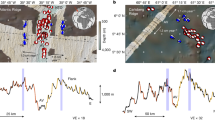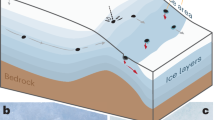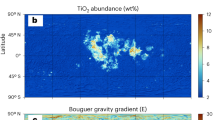Abstract
On 28 March 2005 the Sunda megathrust in Indonesia ruptured again, producing another great earthquake three months after the previous one. The rupture was contiguous with that of the December 2004 Sumatra–Andaman earthquake, and is likely to have been sparked by local stress, although the triggering stresses at its hypocentre were very small — of the order of just 0.1 bar. Calculations show that stresses imposed by the second rupture have brought closer to failure the megathrust immediately to the south, under the Batu and Mentawai islands, and have expanded the area of increased stress on the Sumatra fault. Palaeoseismologic studies show that the Mentawai segment of the Sunda megathrust is well advanced in its seismic cycle and is therefore a good candidate for triggered failure.
This is a preview of subscription content, access via your institution
Access options
Subscribe to this journal
Receive 51 print issues and online access
$199.00 per year
only $3.90 per issue
Buy this article
- Purchase on Springer Link
- Instant access to full article PDF
Prices may be subject to local taxes which are calculated during checkout

Similar content being viewed by others
References
McCloskey, J., Nalbant, S. S., & Steacy, S. Nature 434, 291 (2005).
Stein, R. S., Barka, A. A. & Dieterich, J. H. Geophys. J. Int. 128, 594–604 (1997).
Pollitz, F. F. & Sacks, I. S. Bull. Seismol. Soc. Am. 87, 1–10 (1997).
Rivera, L. et al. Bull. Seismol. Soc. Am. 92, 1721–1736 (2002).
Natawidjaja, D. H. et al. J. Geophys. Res. 109, B04306 (2004).
Sieh, K., Stebbins, C., Natawidjaja, D. H. & Suwargadi, B. W. EOS Trans. AGU 85, Abstr. PA23A-1444 (2005).
Newcomb, K. R. & McCann, W. R. J. Geophys. Res. 92, 421–439 (1987).
Ji, C. http://www.gps.caltech.edu/~jichen/Earthquake/2005/sumatra/sumatra.html (2005).
Yagi, Y. http://iisee.kenken.go.jp/staff/yagi/eq/Sumatra2004/Sumatra2004.html (2005).
Pollitz, F. F., Burgmann, R. & Romanowichz, B. Science 280, 1245–1249 (1998).
Author information
Authors and Affiliations
Corresponding author
Ethics declarations
Competing interests
The authors declare no competing financial interests.
Rights and permissions
About this article
Cite this article
Nalbant, S., Steacy, S., Sieh, K. et al. Earthquake risk on the Sunda trench. Nature 435, 756–757 (2005). https://doi.org/10.1038/nature435756a
Published:
Issue Date:
DOI: https://doi.org/10.1038/nature435756a
This article is cited by
-
General Review of the Worldwide Tsunami Research
Journal of Marine Science and Application (2023)
-
Are current tsunami evacuation approaches safe enough?
Stochastic Environmental Research and Risk Assessment (2021)
-
Review on Recent Progress in Near-Field Tsunami Forecasting Using Offshore Tsunami Measurements: Source Inversion and Data Assimilation
Pure and Applied Geophysics (2021)
-
Over 100 years of faults interaction, stress accumulation, and creeping implications, on Chaman Fault System, Pakistan
International Journal of Earth Sciences (2019)
-
Twenty-Five Years of Progress in the Science of “Geological” Tsunamis Following the 1992 Nicaragua and Flores Events
Pure and Applied Geophysics (2019)
Comments
By submitting a comment you agree to abide by our Terms and Community Guidelines. If you find something abusive or that does not comply with our terms or guidelines please flag it as inappropriate.



